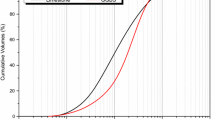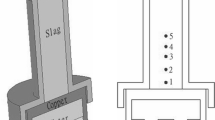Abstract
Ladle slag, currently an under-utilized crystalline metallurgical residue, was studied for use as a precursor for alkali activation. An activating solution containing sodium silicate and potassium hydroxide was used in activating the slag with varying compositional ratios in order to optimize the compressive strength. Ladle slag is commonly regarded as having limited reaction with alkalis, and in previous studies, it has been therefore mixed with reactive precursors, such as metakaolin. However, based on our results, ladle slag shows potential as a sole precursor for alkali-activated binders. X-ray diffractometry reveals that the major minerals in the ladle slag were identified to be γ-dicalcium silicate and mayenite. After alkali activation, the major reaction product was a silicate hydrate according to DRIFT analysis–sodium-substituted calcium aluminosilicate hydrate gel, C–(N)–A–S–H. XRD analysis supports the hypothesis by revealing an amorphous “halo” in the alkali-activated slag. The unconfined compressive strength of the optimized alkali-activated ladle slag paste specimen was 65 MPa at 28 days.











Similar content being viewed by others
References
Euroslag (2012). http://www.euroslag.com/products/statistics/2012/. Accessed 8 Mar 2016
Serjun VZ, Mirtič B, Mladenovič A (2013) Evaluation of ladle slag as a potential material for building and civil engineering. Mater Tehnol 47:543–550
Tracz T, Hager I, Sideris KK, et al (2015) In: 7th Scientific-technical conference on material problems in civil engineering MATBUD’2015Production of durable self-compacting concrete using ladle furnace slag (LFS) as filler material. Procedia Engineering, vol 108, pp 592–597. doi: 10.1016/j.proeng.2015.06.184
Manso JM, Rodriguez Á, Aragón Á, Gonzalez JJ (2011) The durability of masonry mortars made with ladle furnace slag. Constr Build Mater 25:3508–3519. doi:10.1016/j.conbuildmat.2011.03.044
Manso JM, Losañez M, Polanco JA, Gonzalez JJ (2005) Ladle Furnace Slag in Construction. J Mater Civ Eng 17:513–518. doi:10.1061/(ASCE)0899-1561(2005)17:5(513)
Andreas L, Diener S, Lagerkvist A (2014) Steel slags in a landfill top cover – Experiences from a full-scale experiment. Waste Manag 34:692–701. doi:10.1016/j.wasman.2013.12.003
Koizumi S, Miki T, Nagasaka T (2015) Enrichment of phosphorus oxide in steelmaking slag by utilizing capillary action. J Sustain Metall. doi:10.1007/s40831-015-0035-3
Buchwald A, Hilbig H, Kaps C (2007) Alkali-activated metakaolin-slag blends—performance and structure in dependence of their composition. J Mater Sci 42:3024–3032. doi:10.1007/s10853-006-0525-6
Guerrieri M, Sanjayan J, Collins F (2009) Residual strength properties of sodium silicate alkali activated slag paste exposed to elevated temperatures. Mater Struct 43:765–773. doi:10.1617/s11527-009-9546-3
Guerrieri M, Sanjayan JG (2010) Behavior of combined fly ash/slag-based geopolymers when exposed to high temperatures. Fire Mater 34:163–175. doi:10.1002/fam.1014
Provis JL, Bernal SA (2014) Geopolymers and related alkali-activated materials. Annu Rev Mater Res 44:299–327. doi:10.1146/annurev-matsci-070813-113515
Pacheco-Torgal F, Labrincha J, Leonelli C et al (2014) Handbook of alkali-activated cements, mortars and concretes. Elsevier, Cambridge
Yip CK, Lukey GC, Provis JL, van Deventer JSJ (2008) Effect of calcium silicate sources on geopolymerisation. Cem Concr Res 38:554–564. doi:10.1016/j.cemconres.2007.11.001
Myers RJ, Bernal SA, San Nicolas R, Provis JL (2013) Generalized structural description of calcium-sodium aluminosilicate hydrate gels: the cross-linked substituted tobermorite model. Langmuir 29:5294–5306. doi:10.1021/la4000473
Provis JL (2013) Geopolymers and other alkali activated materials: why, how, and what? Mater Struct 47:11–25. doi:10.1617/s11527-013-0211-5
Chi M (2012) Effects of dosage of alkali-activated solution and curing conditions on the properties and durability of alkali-activated slag concrete. Constr Build Mater 35:240–245. doi:10.1016/j.conbuildmat.2012.04.005
Kriskova L, Pontikes Y, Zhang F et al (2014) Influence of mechanical and chemical activation on the hydraulic properties of gamma dicalcium silicate. Cem Concr Res 55:59–68. doi:10.1016/j.cemconres.2013.10.004
Salman M, Cizer Ö, Pontikes Y et al (2015) Cementitious binders from activated stainless steel refining slag and the effect of alkali solutions. J Hazard Mater 286:211–219. doi:10.1016/j.jhazmat.2014.12.046
Salman M, Cizer Ö, Pontikes Y et al (2014) Effect of curing temperatures on the alkali activation of crystalline continuous casting stainless steel slag. Constr Build Mater 71:308–316. doi:10.1016/j.conbuildmat.2014.08.067
Kriskova L, Pontikes Y, Cizer Ö et al (2012) Effect of mechanical activation on the hydraulic properties of stainless steel slags. Cem Concr Res 42:778–788. doi:10.1016/j.cemconres.2012.02.016
Salman M, Cizer Ö, Pontikes Y et al (2015) Alkali activation of AOD stainless steel slag under steam curing conditions. J Am Ceram Soc 98:3062–3074. doi:10.1111/jace.13776
Bignozzi MC, Manzi S, Lancellotti I et al (2013) Mix-design and characterization of alkali activated materials based on metakaolin and ladle slag. Appl Clay Sci 73:78–85. doi:10.1016/j.clay.2012.09.015
Lancellotti I, Ponzoni C, Bignozzi MC et al (2014) Incinerator bottom ash and ladle slag for geopolymers preparation. Waste Biomass Valoriz 5:393–401. doi:10.1007/s12649-014-9299-2
Natali Murri A, Rickard WDA, Bignozzi MC, Van Riessen A (2013) High temperature behaviour of ambient cured alkali-activated materials based on ladle slag. Cem Concr Res 43:51–61. doi:10.1016/j.cemconres.2012.09.011
Natali A, Manzi S, Bignozzi MC (2011) Novel fiber-reinforced composite materials based on sustainable geopolymer matrix. Procedia Eng 21:1124–1131. doi:10.1016/j.proeng.2011.11.2120
Bougara A, Lynsdale C, Ezziane K (2009) Activation of Algerian slag in mortars. Constr Build Mater 23:542–547. doi:10.1016/j.conbuildmat.2007.10.012
Torgal FP, Jalali S (2011) Eco-efficient construction and building materials. Springer, London
SFS Online (2009) SFS 5513 - Brick Tile Testing (Finnish standard). https://online.sfs.fi/fi/index/tuotteet/SFS/SFS/ID2/5/119637.html.stx. Accessed 22 Dec 2015
Garcia-Lodeiro I, Palomo A, Fernández-Jiménez A (2014) An overview of the chemistry of alkali-activated cement-based binders. In: Handbook of Alkali-activated cements, mortars and concretes, pp 19–47
Majumbar AJ, Singh B, Edmonds RN (1989) Hydration of mixtures of C12A7 and granulated blastfurnace slag. Cem Concr Res 19:848–856. doi:10.1016/0008-8846(89)90097-5
Adolfsson D, Robinson R, Engström F, Björkman B (2011) Influence of mineralogy on the hydraulic properties of ladle slag. Cem Concr Res 41:865–871. doi:10.1016/j.cemconres.2011.04.003
Collins F, Sanjayan JG (1999) Strength and shrinkage properties of alkali-activated slag concrete containing porous coarse aggregate. Cem Concr Res 29:607–610. doi:10.1016/S0008-8846(98)00203-8
Shi C, Roy D, Krivenko P (2006) Alkali-activated cements and concretes. CRC Press, Boca Raton
Nikolić I, Drinčić A, Djurović D et al (2016) Kinetics of electric arc furnace slag leaching in alkaline solutions. Constr Build Mater 108:1–9. doi:10.1016/j.conbuildmat.2016.01.038
Yu P, Kirkpatrick RJ, Poe B et al (1999) Structure of Calcium Silicate Hydrate (C-S-H): near-, Mid-, and Far-Infrared Spectroscopy. J Am Ceram Soc 82:742–748. doi:10.1111/j.1151-2916.1999.tb01826.x
Lecomte I, Henrist C, Liégeois M et al (2006) (Micro)-structural comparison between geopolymers, alkali-activated slag cement and Portland cement. J Eur Ceram Soc 26:3789–3797. doi:10.1016/j.jeurceramsoc.2005.12.021
Zhang Z, Wang H, Provis JL et al (2012) Quantitative kinetic and structural analysis of geopolymers. Part 1. The activation of metakaolin with sodium hydroxide. Thermochim Acta 539:23–33
Gao X, Yu QL, Brouwers HJH (2015) Characterization of alkali activated slag–fly ash blends containing nano-silica. Constr Build Mater 98:397–406. doi:10.1016/j.conbuildmat.2015.08.086
Garcia-Lodeiro I, Palomo A, Fernández-Jiménez A, Macphee DE (2011) Compatibility studies between N-A-S-H and C-A-S-H gels. Study in the ternary diagram Na2O–CaO–Al2O3–SiO2–H2O. Cem Concr Res 41:923–931. doi:10.1016/j.cemconres.2011.05.006
Bernal SA, Provis JL, Rose V, Mejía de Gutierrez R (2011) Evolution of binder structure in sodium silicate-activated slag-metakaolin blends. Cem Concr Compos 33:46–54. doi:10.1016/j.cemconcomp.2010.09.004
Kupaei RH, Alengaram UJ, Jumaat MZ et al (2014) The effect of different parameters on the development of compressive strength of oil palm shell geopolymer concrete. Sci World J Sci World J 2014:e898536. doi:10.1155/2014/898536
Qureshi MN, Ghosh S (2013) Effect of Alkali Content on Strength and Microstructure of GGBFS Paste. Glob J Res Eng 13
Zhang Z, Yang T, Wang H (2014) The effect of efflorescence on the mechanical properties of fly ash-based geopolymer binders. In: 23rd Australas conference on the mechanics of structures and materials ACMSM23, pp 107–112
Posi P, Lertnimoolchai S, Sata V, Chindaprasirt P (2013) Pressed lightweight concrete containing calcined diatomite aggregate. Constr Build Mater 47:896–901. doi:10.1016/j.conbuildmat.2013.05.094
Jud Sierra E, Miller SA, Sakulich AR et al (2010) Pozzolanic activity of diatomaceous earth. J Am Ceram Soc 93:3406–3410. doi:10.1111/j.1551-2916.2010.03886.x
Qureshi MN, Ghosh S (2014) Effect of silicate content on the properties of Alkali-activated blast furnace slag paste. Arab J Sci Eng 39:5905–5916. doi:10.1007/s13369-014-1172-x
Petrović DV, Mitrović ČB, Trišovic NR, Golubović ZZ (2011) On the particles size distributions of diatomaceous earth and perlite granulations. Stroj Vestn J Mech Eng 57:843–850. doi:10.5545/sv-jme.2010.050
Pimraksa K, Chindaprasirt P (2009) Lightweight bricks made of diatomaceous earth, lime and gypsum. Ceram Int 35:471–478. doi:10.1016/j.ceramint.2008.01.013
Acknowledgments
This work was supported by the European Regional Development Fund (Project Code: A70189) and the following Finnish companies: Ekokem Oy, SSAB Europe Oy, Stora Enso Oyj, Pohjolan Voima Oy, and Oulun Energia. The contributions of Jarno Karvonen and Jani Österlund to the laboratory analyses are gratefully acknowledged.
Author information
Authors and Affiliations
Corresponding author
Additional information
The contributing editor for this article was Yiannis Pontikes.
Rights and permissions
About this article
Cite this article
Adesanya, E., Ohenoja, K., Kinnunen, P. et al. Alkali Activation of Ladle Slag from Steel-Making Process. J. Sustain. Metall. 3, 300–310 (2017). https://doi.org/10.1007/s40831-016-0089-x
Published:
Issue Date:
DOI: https://doi.org/10.1007/s40831-016-0089-x




